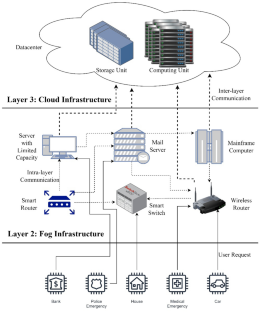Journal of Ambient Intelligence and Humanized Computing ( IF 3.662 ) Pub Date : 2024-04-21 , DOI: 10.1007/s12652-024-04796-w Satveer Singh , Deo Prakash Vidyarthi

|
It has been observed that Cloud services exhibit suboptimal performance for real-time requests due to increased network delay. Fog computing has emerged to address this issue by deploying Fog nodes at the network's edge. However, determining the optimal placement of Fog nodes for efficient service processing poses a significant challenge. The multiple ways to deploy a Fog node makes the Fog node placement an NP-class problem. It leverages the potential benefit of metaheuristic to solve this problem. In this work, we formulate a linear mathematical model for fog node placement (FNP), considering two important objectives for minimization, i.e., deployment cost (DC) and network latency (NL). A hybrid metaheuristic approach using genetic algorithm (GA) and JAYA, called JAYA-GA, is proposed to address this multi-objective optimization. The proposed model is simulated and the experimental results are compared against three popularly used metaheuristics: particle swarm optimization (PSO), GA, and JAYA. The proposed model consistently outperforms JAYA, PSO, and GA by the averages of 18.40%, 33.58%, and 30.75%, respectively, in terms of fitness (a weighted sum of DC and NL). Additionally, it exhibits superior performance on average convergence rate (16.60%, 53.42%, and 86.59%) and computation time (15.76%, 34.74%, and 59.22%) compared to JAYA, PSO, and GA respectively. Thus, the simulation results establish that the hybrid JAYA-GA technique surpasses the state-of-the-art alternatives on DC, NL, besides computation time and convergence rate.
中文翻译:

使用 JAYA-GA 元启发法在雾集成云中放置雾节点的混合模型
据观察,由于网络延迟增加,云服务对于实时请求的性能表现不佳。雾计算的出现是为了通过在网络边缘部署雾节点来解决这个问题。然而,确定雾节点的最佳放置以实现高效的服务处理提出了重大挑战。部署Fog节点的多种方式使得Fog节点的放置成为一个NP类问题。它利用元启发式的潜在好处来解决这个问题。在这项工作中,我们制定了雾节点放置(FNP)的线性数学模型,考虑了最小化的两个重要目标,即部署成本(DC)和网络延迟(NL)。提出了一种使用遗传算法 (GA) 和 JAYA 的混合元启发式方法(称为 JAYA-GA)来解决这种多目标优化问题。对所提出的模型进行了仿真,并将实验结果与三种常用的元启发法进行了比较:粒子群优化 (PSO)、GA 和 JAYA。所提出的模型在适应度(DC 和 NL 的加权和)方面始终优于 JAYA、PSO 和 GA,平均分别为 18.40%、33.58% 和 30.75%。此外,与 JAYA、PSO 和 GA 相比,它在平均收敛率(16.60%、53.42% 和 86.59%)和计算时间(15.76%、34.74% 和 59.22%)上分别表现出优越的性能。因此,仿真结果表明,除了计算时间和收敛速度之外,混合 JAYA-GA 技术还超越了 DC、NL 上最先进的替代方案。



























 京公网安备 11010802027423号
京公网安备 11010802027423号